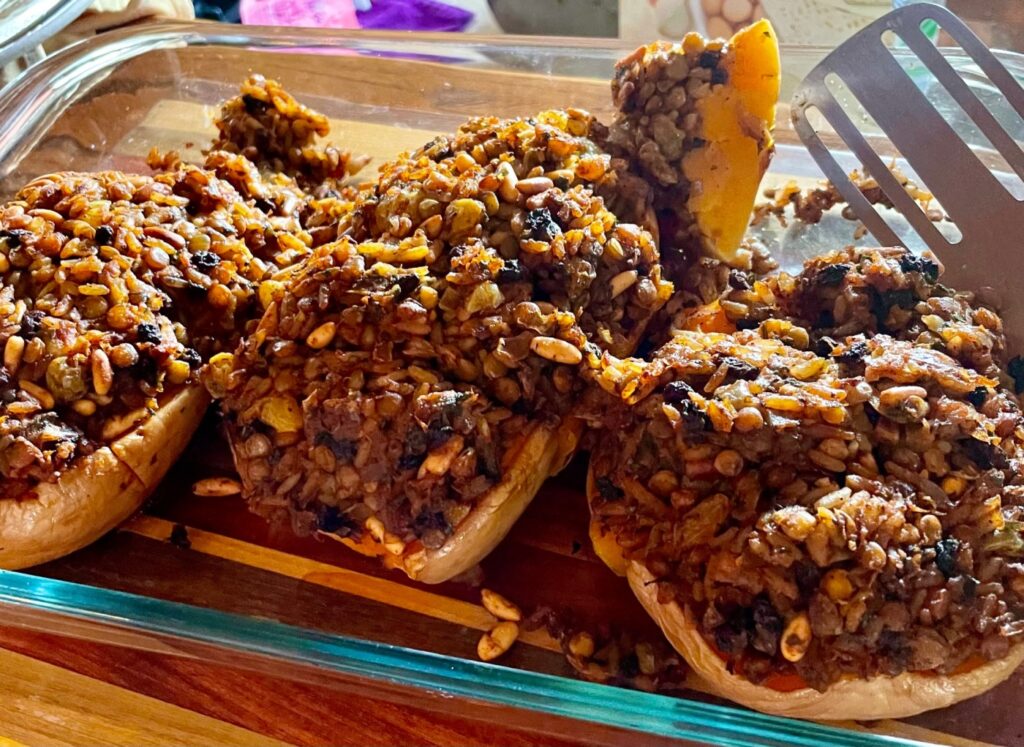
“What can I bring?”
You’re invited for dinner, and those four words come automatically, so when Joyce Simpson of Santa Ana invited me for dinner, she suggested a side dish, and “could you possibly make it vegan?”
No problem! My go-to stuffed butternut squash from “Jewish Traditional Cooking” (Simon and Schuster, $30) by Ruth Joseph and Simon Round, was a big hit (as usual!) and was loved by carnivores and vegans alike.
I have brought this dish to potlucks many times and have astounded the vegetarians and vegans who find the stuffing so meaty they can’t believe I hadn’t hidden some in there.
Maybe you’ve eyed that big, pear-shaped giant of a squash and thought, too much trouble.
You could lose a finger cutting through that tough skin! Here’s what I do: I pierce that baby three or four times with a skewer (so it won’t burst) and microwave it on high for four or five minutes, making it easier to cut, and then proceed with the recipe, shaving off the roasting time a hair.
Precut, cubed butternut squash, available in supermarkets, makes short work of some recipes.
No exact recipe here, but I like to cut the cubes even smaller, throw in some maple syrup and brown sugar, sprinkle with salt, cinnamon, cloves, ginger and nutmeg and roast in an oiled pan at 425 degrees for 20 minutes. Then I turn the cubes with a wide spatula, and continue roasting until sufficiently brown and meltingly sticky and yummy, maybe another 15 minutes. Sometimes I turn off the oven and leave them there a while for extra crispness.
Butternut squash is a great source of fiber, vitamins A, C and E as well as manganese, magnesium and potassium. It is believed that wild squash was eaten in the Americas 10,000 years ago. Native Americans would bury it with the dead to provide nutrition, and the seeds were thought to enhance fertility. The Incas cultivated it in the 15th century.
Charles A. Leggett is credited with creating the butternut squash and coining the name.
In the mid 1940s, Leggett crossed the gooseneck squash, which was difficult to transport because of its long, gangly shape, with the giant-sized Hubbard squash. He was looking for a regularly formed squash that was compact and easier to prepare. He thought the hybrid was “smooth as butter and sweet as a nut,” and the name stuck.
Actually classified as a fruit, butternut squash can be roasted, mashed in baked goods and casseroles or puréed for soups. Combine roasted cubes with black beans for amazing vegetarian tostadas, use it in pies instead of pumpkin, add cubes to a kale salad, top a pizza with it along with spinach and goat cheese or add Greek yogurt and tahini to puréed roasted garlic and squash for a tangy Mediterranean dip.
Fullerton’s Judy Bart Kancigor is the author of “Cooking Jewish” and “The Perfect Passover Cookbook.” Her website is cookingjewish.com.
Stuffed Butternut Squash
Adapted from “Jewish Traditional Cooking” by Ruth Joseph and Simon Round. I cook the squash and prepare the stuffing in advance, but mix in pine nuts right before stuffing the squash for that extra crunch.
Serves: 6-8
Ingredients:
1 large butternut squash (at least 2 pounds)
Kosher salt and freshly ground black pepper
3 tablespoons olive oil, plus extra for brushing
1 large onion, chopped
2 garlic cloves, finely chopped
1 1/2 teaspoons good quality paprika
2 tablespoons white wine
2 tablespoons tomato paste
1 cup cooked green lentils (made according to package directions)
1 cup cooked brown rice (made according to package directions)
1/2 cup currants
1/4 cup dill, finely chopped
1/2 cup fresh cilantro, finely chopped
1 teaspoon ground cinnamon
1/3 cup pine nuts, toasted
Method:
1. Preheat oven to 375 degrees. Cut squash in half, scoop out seeds, and discard. Make crisscross cuts into flesh; brush top with oil. Season well with salt and pepper, and place in roasting pan. Bake 30 minutes.
2. In large saucepan, gently cook onions in oil until soft, but not colored. Add garlic last 2 minutes of cooking. Stir in paprika. Add wine and cook until almost evaporated. Stir in remaining ingredients. Add salt and pepper to taste.
3. Fill squash cavities with lentil-rice mixture; bake, covered, another 30 minutes or until squash is very soft.
